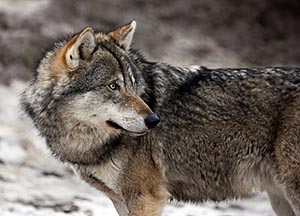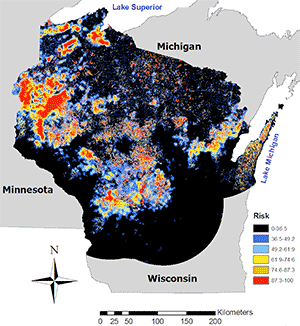Livestock risks from Wisconsin wolves localized, predictable
It’s an issue that crops up wherever humans and big predators — wolves, bears, lions — coexist.
“It’s just hard to live alongside large carnivores. They damage crops, they kill livestock and pets, they threaten people’s safety,” says University of Wisconsin–Madison professor Adrian Treves. And the sheer presence of a wolf nearby has typically been enough to make farmers fear for their animals, he adds. “Wherever there were carnivores, people thought there was risk.”
A map showing the predicted risks of grey wolf attacks on livestock in parts of Wisconsin located within 100 kilometers of known wolf packs. The highest-risk regions, shown in red, comprise just 10 percent of the area within wolf ranges and are concentrated in northwestern parts of the state and near Lake Superior. “The ability to predict potential attacks will help target prevention and management efforts with the goal of reducing conflicts between people and wolves”, says UW–Madison environmental studies professor Adrian Treves. Map credit: Adrian Treves
High-resolution image
But Red Riding Hood and the Three Little Pigs notwithstanding, not all wolves are big and bad. Even as Wisconsin’s wolf population grows, intensifying the potential for conflicts with people, Treves’ research is revealing that one of the most visible types of conflict — attacks on livestock — is highly localized and may be predictable.
Treves, head of the Carnivore Coexistence Laboratory in the UW–Madison Nelson Institute for Environmental Studies, works in partnership with the Wisconsin Department of Natural Resources to understand and mediate human-carnivore conflicts with an eye toward reducing the threat to both people and animals.
When problems arise, Treves says, “people traditionally respond by retaliating, either by clearing wildlife habitat or by killing the carnivores.”
It’s an approach that simply isn’t sustainable, he says, noting that top carnivores are linchpin species in many ecosystems and among the most endangered species on the planet. “How do you balance people’s need for safety and their livelihoods — livestock and crops — how do you balance that human need with the global imperative to conserve nature?”
Their research on the topic has now yielded a risk map of wolf attacks on livestock in Wisconsin, which identifies areas of high and low risk throughout the state. The study, co-authored with Adrian Wydeven and Jane Wiedenhoeft of the Wisconsin DNR and Kerry Martin of UW–Madison, appears in the June issue of the journal BioScience.
Risk mapping is already used in a wide range of settings, from police activity to outbreaks of infectious disease, as a way to mobilize and manage resources. It’s a very common-sense approach, Treves says, based on identifying characteristics that distinguish affected sites from neighboring unaffected sites.
“If we can isolate the factors that make them different, we should be able to predict where those attacks will happen in the future and we can target our prevention to the highest-risk areas,” he says.
Their analysis, using 133 documented livestock attacks between 1999 and 2006, highlighted three variables that predicted higher risk of wolf attacks: higher percentage of pasture, grassland or hayfield; closer proximity to the nearest wolf pack; and greater distance from forest.

Not all grey wolves in Wisconsin pose equal threat to people and livestock. UW–Madison researcher Adrian Treves found that only a small fraction of the state is at high risk of wolf attacks on livestock.
Of the parts of Wisconsin within 100 kilometers of a wolf pack (most of the state, excluding the southern and southeastern-most regions), only one-third of the study area was found to be at risk of wolf attacks on livestock. The highest-risk areas comprise just 10.5 percent, concentrated in the northwest and a few pockets near Lake Superior.
The researchers also verified their model using data from 2007-09 and found that their risk map correctly predicted the vast majority (88 percent) of those incidents.
Treves says it’s a good start to help farmers and resource managers target prevention efforts on those high-risk hotspots, distribute limited resources as efficiently and effectively as possible and, hopefully, reduce livestock attacks.
“Prediction promotes prevention,” he says. “Every single wolf pack in Wisconsin has access to people or pets or livestock,” but with only a handful implicated in attacks each year, “the majority of the wolf population is not causing problems.”




